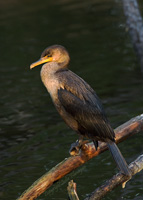Description: The American Bittern is a medium- to large-sized heron with a stout body and a neck, short legs, and a white neck. It is 59-70 cm (23-27 inches) in length, with a 95-115 cm (37 - 45 inch) wingspan. The upper side of the bird is brown finely speckled with black. The undersides are heavily streaked with brown and white. There is a long black patch that extends from below the eye down the side of the neck. Habitat: In the breeding range, the American Bittern inhabits areas of freshwater wetlands with tall emergent vegetation, shorelines, and vegetative fringes. The bird prefers beaver-created wetlands to those of glacial origin. Although common in much of its range, the American Bittern is usually well-hidden in bogs, marshes and wet meadows. This bittern winters in the southern United States and Central America. It summers throughout Canada and much of the United States. As a long-distance migrant, it is a very rare vagrant in Europe, including Great Britain and Ireland. This bird's numbers have declined in the southern parts of its range due to habitat loss. Breeding: The American Bittern is considered monogamous; however, it is possibly polygamous under some circumstances. Pair formation occurs in early May when the female arrives at the nesting site. The female then chooses the nest site, which is usually in dense emergent vegetation over water that is 4-5 cm in depth. The nest is built by the female and is constructed of reeds, sedges, cattail, or other emergent vegetation; the male guards it. Egg laying is performed daily with one egg laid in the in the morning. Two or three eggs get incubated by the female. Incubation begins before the full clutch is laid and lasts 24 to 28 days, and the chicks leave after 6-7 weeks. Brooding and feeding duties are performed solely by the female. The hatchlings leave the nest after one to two weeks, but they receive supplemental feedings by the adults up to four weeks after hatching. Behavior: Usually solitary, it walks stealthily among cattails or bullrushes. If it senses that it has been seen, the American Bittern becomes motionless, with its bill pointed upward, causing it to blend into the reeds. It is most active at dusk. More often heard than seen, this bittern has a call that resembles a congested pump. Little is known about migration patterns of the species. Northern populations that occupy areas where temperatures can reach below freezing are known to migrate. Southern populations occupying regions where temperatures are milder, however, appear to be non-migratory. Members of the species appear to be highly asocial, with minimal pair bonds between the sexes. Foraging is completely solitary. Diet: Like other members of the heron family, the American Bittern feeds in marshes and shallow ponds, dining on includes insects, amphibians, crayfish, and small fish and mammals. When foraging, it relies mostly on stealth, waiting motionless for its prey to pass by. Its coloration adds to its ability to go undetected by prey. When its prey is in reach, the bird darts forward and seizes the prey in its bill. The prey is then killed by biting or shaking and is swallowed head first. Microhabitats for foraging include vegetation fringes and shorelines. Even-aged stands of older, dense or dry vegetation are avoided. Conservation Status: Least Concern. The American Bittern population is undergoing a substantial decline due to loss and degradation of habitat. The species was listed as a Nongame Species of Management Concern by the United States Fish and Wildlife Service in 1982 and 1987. It is listed as a species of special concern in the state of Michigan. Eutrophication, siltation, chemical contamination, and human disturbance have significantly reduced habitat quality by damaging the food supply. Changes in wetland isolation and stabilized water regimes are also eroding habitat quality. Acid rain is also another significant threat to the species due to its damaging effects on wetlands. The American Bittern is protected under the Migratory Bird Treaty Act of 1918. Interesting Fact(s): No subspecies are accepted today. However, fossils found in the Ichetucknee River, Florida, and originally described as a new form of heron (Palaeophoyx columbiana) were later recognized to be a smaller, prehistoric subspecies of the American Bittern which lived during the Late Pleistocene and would thus be called B. l. columbianus. Many of the folk names are given for its distinctive call made by inhaling and exhaling large quantities of air; E. Choate lists "Bogbumper" and "Stake Driver". Pliny likened the old-world bittern's call to the roaring of a bull, "boatum tauri", whence the generic name Botaurus. Written by Sarko Sarkodie Source(s): |
Home | Upcoming Events | About Us | Resource Issues | News | Local Contacts Maps | Photos | Publications | Youth Education | FAQ's | Links | Membership |






